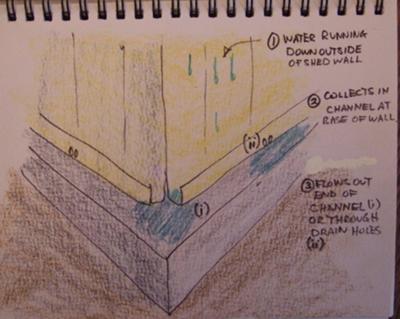Sealing Around the Base of a Shed
by Barry
(Australia)
I'm erecting a small used shed on a concrete slab 2m x 2m which requires waterproofing around the bottom edges before I use dynabolts to secure it to the concrete. What would you recommend I use as a water resistant barrier? I have been told that mastic is good, so what do you say about that?
Answer to: Sealing a Shed Base
by: John - Admin
Hi Barry,
The advice you received about using the mastic sealant is correct. Make sure that you use a silicone sealant for external use with concrete and metal. A typical silicon mastic will state that it will 'cure to give a permanently elastic weatherproof seal with excellent durability and resistance to U.V light.'
Although it says this most mastic sealants do lose their grip and also become less flexible over the years. The way to avoid this becoming a problem with your shed is to make sure that the concrete base does not protrude too far beyond the wall of the shed. The typical advice here I think is that the size of the base should go an inch or two beyond the wall on each side. This gives a very small area for any water to collect.
Let me know how you get on.
Cheers
John
Thanks
by: Barry
Hi John,
Thank you for your advice, I'll give it a go and let you know how successful I was.
Many thanks, Cobber,
Barry.
Click here to read or post comments
Water leaking under shed
by Ed
(Long Island)
John,
I have an older aluminum shed with one side of the shed sitting on a concrete slab.
Water seems to be leaking under the shed when it rains.
How can I waterproof that side of the shed where the aluminum meets the concrete?
What will adhere to aluminum and concrete and form a seal that will last?
Cheers
Ed
Shedman says
Hi Ed,
Thanks for your question, as I have a bit of relevant experience here with sealing around the base of a neighbours’ shed.
Looking at the picture above, water drains down the walls of the shed and gets caught up in a small channel that runs around the base of the shed. The water then flows out of this channel either through small holes that are pre-drilled in the side of the channel or at the end.
As the water flows out of this channel and on to a flat surface or one sloping back into the shed then you will get water leaking in under the shed wall.
The solution if you are building a shed like this from new is to identify these holes and make sure that where they are located the ground/concrete slopes away from the shed in this area.
To solve this problem with an existing shed you may be able to chisel some small channels in the concrete to direct the water away from the shed. Alternatively you can use a mastic sealant as described in the question at the top of this page.
If you go down the sealant route and can't correct this micro drainage problem the water will still collect around the edge of the shed but once it reaches a certain amount it drain over the side. If you get the seal good enough it will stop most of the water entering the shed.
The best solution is only achieved when the shed is first built. Sealing around the base afterward is a less than optimal solution.
Best of luck
John

Keep in touch with our monthly newsletter
Shed Building Monthly





